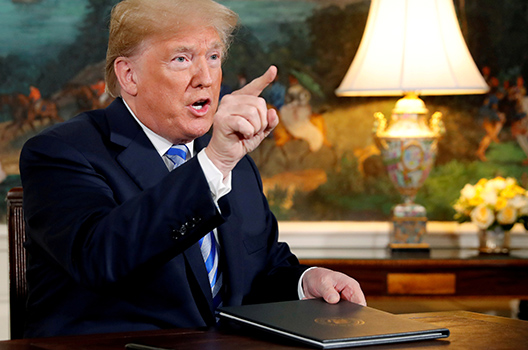 On Monday, US President Donald J. Trump signed an executive order detailing the framework for re-imposing sanctions on Iran, which were lifted under the JCPOA (Joint Comprehensive Plan of Action) nuclear deal, with the goal of getting Iran back to the table to negotiate a deal covering not just Iran’s nuclear weapons program, but also Tehran’s other malign activity. Immediately after issuing the order, Trump tweeted that these were the most biting sanctions ever and would be ratcheted up to another level in November. This is, of course, not true.
On Monday, US President Donald J. Trump signed an executive order detailing the framework for re-imposing sanctions on Iran, which were lifted under the JCPOA (Joint Comprehensive Plan of Action) nuclear deal, with the goal of getting Iran back to the table to negotiate a deal covering not just Iran’s nuclear weapons program, but also Tehran’s other malign activity. Immediately after issuing the order, Trump tweeted that these were the most biting sanctions ever and would be ratcheted up to another level in November. This is, of course, not true.
The sanctions the administration is re-imposing in two waves (August and November) on Iran are effectively the same sanctions that were in place in 2013 and led to the JCPOA negotiations. Unlike 2013, the Trump administration does not have the full support of the international community and is not bolstered by several United Nations Security Council resolutions imposing sanctions on Iran to generate maximum pressure on Tehran. Instead, the US withdrawal from the JCPOA has caused an ugly split with our European allies who passed a blocking regulation preventing EU companies from complying with US sanctions on Iran and has drawn the ire of the other deal signatories, China and Russia, and key partners – such as Turkey, India, Japan, and South Korea – who went along with US sanctions in 2013.
The EU blocking regulation will probably cause some headaches, especially for companies with a presence in both the United States and EU. At the end of the day, however, the blocking regulation is unlikely to be much more than a bargaining chip. The EU economy is too tightly intertwined with the US economy, particularly the dollar, to risk being cut off; Germany last week passed a law that could undercut the blocking regulation and allow German firms to avoid financial transfers that could trigger US sanctions.
However, opposition from other key players – namely, China, India, Turkey, and Russia – is likely to undermine the maximum pressure gambit. All have expressed significant opposition to falling in line with US secondary sanctions, and all (except India, perhaps) could potentially establish trade channels with Iran that are able to withstand US sanctions, as China did with the Bank of Kunlun prior to the JCPOA.
The sanctions re-imposed this week are important measures that will put further pressure on Iran’s teetering economy. They target, among other areas, Iran’s ability to trade in precious metals, and will undercut Iran’s ability to sustain the value of its currency, the rial, which has plummeted in recent months. The second tranche of the US sanctions, which go into effect in November to target Iran’s petrochemical and banking sectors, will provide a better indication whether the administration’s sanctions push can be effective.
The administration has stated publicly that it would like to get Iran’s oil exports as close to zero as possible in order to starve the regime of funds it uses to foment unrest in the region, fund its ballistic missile program, and prop up its kleptocratic regime. Near zero exports should not be the driving goal here, though, and is frankly unrealistic, given the broad objections to the US JCPOA withdrawal. Instead, the administration should focus on using the leverage provided by one particular sanctions provision contained in the 2012 National Defense Authorization Act (NDAA). This provision effectively allows for countries to import a significantly reduced volume of oil from Iran but forces any proceeds of those oil purchases to be housed in the purchasing jurisdiction and only used for non-sanctionable bilateral trade. Using this provision expansively would tie up Iranian oil revenues in such a way that they cannot be used easily for nefarious purposes, and could also generate some diplomatic space to press for more stringent implementation of other trade sanctions.
Even if the administration plays its cards right, it’s difficult to see enough of a global coalition supporting it – absent Iran restarting its nuclear program or otherwise shooting itself in the foot – to have the same effect as the US sanctions had in 2013. The key things to look for to gauge how close the sanctions effect can get to 2013 will be whether the EU aggressively uses the blocking regulation, whether the United States uses the NDAA provision to make a compromise on Iranian oil exports, and the role of spoiler that China, India, Turkey, and Russia will play. These issues, along with the performance of Iran’s economy, are likely to be the most critical in determining whether these renewed sanctions can spur the Trump Administration’s goal of an Iran deal that addresses the full scope of Iran’s malign activities.
Brian O’Toole is a nonresident senior fellow with the Atlantic Council’s Global Business and Economics Program. Follow him on Twitter @brianoftoole.
Image: U.S. President Donald Trump speaks to reporters after signing a proclamation declaring his intention to withdraw from the JCPOA Iran nuclear agreement in the Diplomatic Room at the White House in Washington, U.S. May 8, 2018. (REUTERS/Jonathan Ernst/File Photo)
